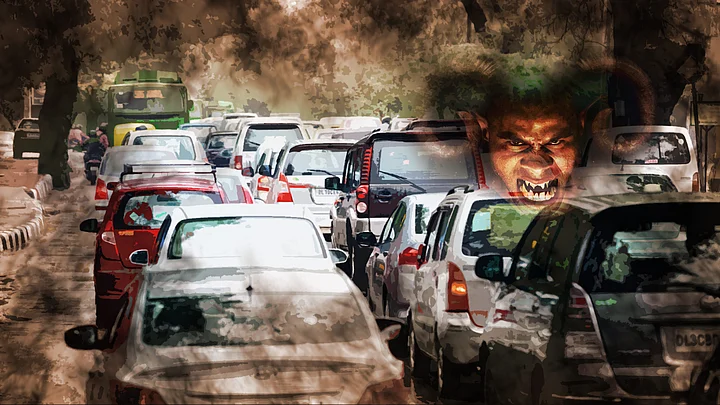25-year-old Mayank, a travel writer with a media house commutes from Rohini (North- West of Delhi) to Noida (South-East Delhi) daily in a carpool with three others since the last one-and-a-half years. The proposed odd-even plan has not gone down well with him. “All exemptions are fine, I’m already in a carpool of four people and all four of us have cars with odd numbers. Either we opt for public transport or choose work-from-home. While my workplace may be flexible, I’m not sure about others.”
Not just inconvenience and impracticality, recent statistical studies also put a question mark on the odd-even plan by the Delhi government. In March 2015, a study conducted by IIT Delhi revealed that only 59% of registered cars and 42% of the registered two-wheelers are in use in Delhi.
Since there is no such policy of de-registration after a four-wheeler is sold or scrapped, figures available with the Delhi Transport Department are unreliable as they are inflated several times. It means that if in 2011, according to the Department, the number of registered cars in Delhi was 2,300,000, then only 59% of them (1,357,000) were actually plying on Delhi’s roads.
While no one can deny the fact that cars and two-wheelers are partners in crime, vehicular exhaust is not the only factor responsible for air pollution in Delhi. A study conducted by Pallavi Pant and others, in association with the University of Birmingham, done in winter in 2013 revealed that wood smoke is responsible for 23.3% of Particulate Matter (PM) 2.5 level at a pollution hotspot in Delhi. A study conducted around Mathura Road witnessed an average traffic flow of 1,70,000 vehicles daily. Contribution of vehicular exhaust and dust to PM 2.5 levels was 18.7% and 14.3% respectively.
Vehicles are an important source of fine PM (i.e. PM 2.5) in the city, but not the only source. In winter, burning several materials – wood, coal, other waste – for heating can become an important source. Diesel generators can be another source, especially locally.
Pallavi Pant, currently pursuing air pollution study at the University of Massachusetts
Direct Exposure to Vehicular Exhaust
In November 2014, the Centre for Science and Environment (CSE) conducted an air monitoring exercise involving some prominent personalities across Delhi, such as Harish Salve (Senior Advocate, Supreme Court and amicus curiae in environmental cases), Bhure Lal (Chairperson, Environment Pollution Prevention and Control, NCR), Randeep Guleria (HoD, Pulmonary Medicine, AIIMS, New Delhi) and few others. It is this CSE study that was submitted to the Delhi government that forms the basis for its vehicle rationalisation move, and mentions how personal PM 2.5 levels are twice the reading of nearest the Delhi Pollution Control Committee (DPCC) station readings. Despite Delhi having a total of 19 monitoring stations, including Noida and Gurgaon, real-time data is available only from 4-5 DPCC monitoring stations.
To an email sent to the CSE, where a question related to the rationale behind the odd-even plan was put forth, we got the following reply:
“The PM has variety of sources, but with regard to combustion sources, the PM2.5 in the national capital region of Delhi is mainly contributed by transport (45%), residential/ biomass (27%), industry (24%) and power sector (4%) according to a study by Indian institute of tropical meteorology of the ministry of earth sciences. In urban areas the composition varies from season to season, but during winter time, the share of coarse particulates reduces and fine particulate levels increase. Therefore, all sources need equally stringent action to improve air quality. Since the emissions from vehicles happens in breathing zone, therefore, the exposure from vehicular exhaust needs to reduced as these are toxic.”
Corrective Action
Is it then simply a clash of studies that is leading to divergent conclusions? Or does it corroborate the need for an exhaustive study of the NCR’s ambient air? Pollution emergency measures can’t hover only around vehicles when power plants, dust, etc are to be blamed equally.
Even the Supreme Court in its December 17 order has given the Delhi government a deadline of April 1, 2016 to comply with the Court’s order related to paving of roads, repairing of pavements and procuring vacuum cleaning machines to clean dust. Other issues related to power plants and emissions would be dealt with in detail during the next hearing due on 5 January.
There is no denying that the situation is grave, and it was not without exasperation that the Delhi High Court described the capital as a gas chamber earlier in December.
Need of the Hour
Environmentalists, like MC Mehta, have welcomed the Delhi government’s move to switch to the odd-even plan. The green activist and lawyer whose PIL paved way for CNG-run commercial vehicles in 1998 says, “We are all suffering together as citizens and steps like these (odd-even move) should be welcome. It is not a knee jerk reaction, in other parts of the world, such a plan has succeeded.”
Because of bad policy, weak enforcement and laid back attitude of the Centre, and the state governments, we have suffered for long. Another problem is that of the powerful automobile lobby.
MC Mehta, Environmentalist and Lawyer
On the issue of lack of substantive study, Mehta says, “No study on the carrying capacity (volume of traffic flow) of Delhi roads has been done. Tell me, who has done that? Carrying capacity of roads should be gauged every five or ten years, a yardstick that is missing right now.”
